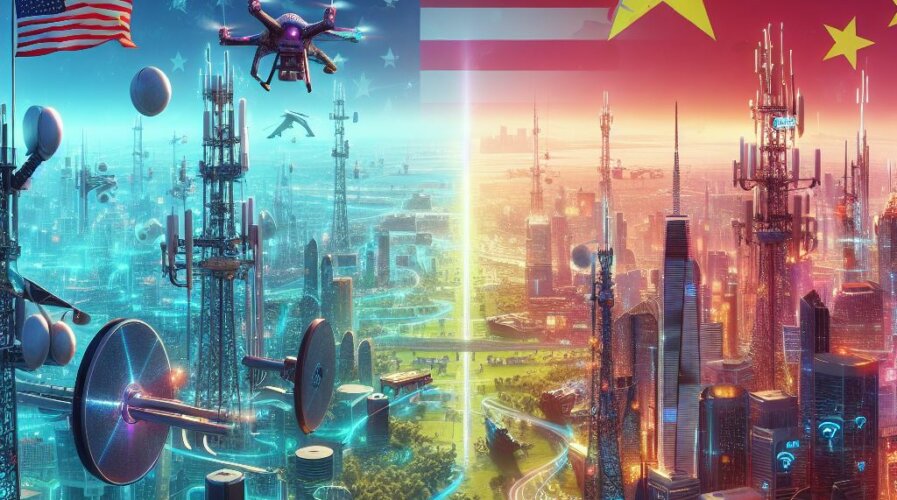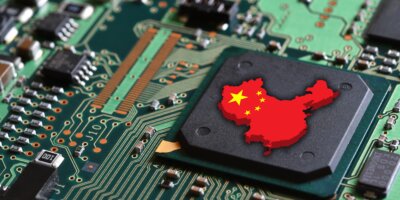
Both the US and China want to harness the Power of AI. (Image generated by AI)
The AI power race: China boosts computing power to take on US
- The US and China are competing for AI supremacy.
- Chinese tech companies want to be leaders in AI by 2030.
- Currently, US companies are leading in AI development.
We’re only at the beginning of our journey to uncover the full potential of the power of AI. Despite AI being around for some time, generative AI has suddenly changed the speed of tech innovation and adoption worldwide. More use cases are being developed, and the fear of being replaced by technology is a concern for many.
Yet, whenever any new technology is unveiled, countries will always compete to make it better and become superior in its development and use.
Today, China and the US are the most significant tech competitors in the world. While both countries continue to develop new tech innovations, their competition to be better at technology than one another also puts them in a league of their own.
China and the US compete in almost anything today. From space exploration to quantum computing to electric vehicles, tech competition between these two great nations can be considered an Olympic event. In some areas, the US has an advantage, given the support of its allies, but China still keeps coming back to surprise the Western powers.
The tech war between the two countries will most likely only continue, and conceivably only be settled eventually by outright hostilities. Tech sanctions on China by the US seem like speed bumps for the country as it develops its technology to remain a key player in industries worldwide. For US companies, sanctions only hamper their trade as most rely on China to produce and manufacture their products, potentially due to the 3.5 times higher average wage in America than in China, as of 2021, which ironically makes China a very capitalist-friendly economic environment.
Recently, Chinese tech giant Huawei proved it could produce a 5G smartphone – the Mate 60 Pro – despite not having access to critical resources.
The smartphone proved that China could develop its own tools and caused panic in the US as it realized its largely punitive and potentially Sinophobic sanctions were not able to effectively retard the technological potential of China.

China wants to be an AI superpower by 2030. (Image generated by AI)
AI is all about power
When OpenAI’s ChatGPT started gaining popularity, China was quick to notice the capabilities of generative AI. Chinese tech companies began working on their own large language models and developing generative AI tools.
But what made the rivalry interesting was that the generative AI tools designed by Chinese tech companies, such as the ERNIE Bot, had capabilities that some felt were better than those developed in the US.
The key ingredient in the AI race is computing power. According to a report by CNBC, China is planning to increase its computing power for AI by up to 50% by 2025. Key ministries in the country are keen to keep pace with the US, especially in AI and supercomputing applications.
CNBC reported that China wants to have a computing capacity of around 300 exaflops (EFLOP). This would be an increase of almost 50% from the 197 exaflop computing power capacity China currently has. For context, one exaflop is equivalent to the computing power of two million mainstream laptop computers, according to Counterpoint Research.
Chinese ministries said that the increased computing power will be required to support applications in industries including finance and education.
“China has found that traditionally, every 1 yuan invested in computing power has driven 3-4 yuan of economic output,” Akshara Bassi, senior research analyst at Counterpoint, told CNBC via email.
“The investments echo China’s plans to drive economic output through leadership in technology prowess and integrating AI with existing technologies and solutions across all industries and domains. China aims to invest in growing its computing power, especially AI, as it sees its major cloud providers launching AI solutions en masse for consumers and enterprises,” said Bassi.
As part of its computing push, China wants to focus on areas such as memory storage and networks for transmitting data, and it is also planning to build more data centers.

China has big ambitions for AI.
AI Innovations in China
While the US has OpenAI, Google, Microsoft, Meta, AWS, and Apple going all out to develop AI, China has Alibaba, Huawei, Tencent, Baidu, SenseTime and ByteDance.
Huawei has already committed to keeping its focus on AI, with the company’s rotating chairwoman and chief financial officer, Meng Wanzhou, announcing as much at a recent event. Huawei, which has focused on cloud computing over the last decade, now wants to be a key player in AI.
Apart from Huawei, Alibaba also made commitments to intensify its focus on AI. Alibaba has invested heavily in developing its LLM. At the same time, Chinese internet giant Baidu hopes its ERNIE Bot will provide the country with much-needed capabilities needed in the field.
Realizing the potential of Chinese tech companies in AI, according to a Bloomberg report, the CIA Open-Source Enterprise division in the US will soon have a ChatGPT-like LLM to provide government snoops with better access to intelligence.
Bloomberg explained that the development would be part of a broader government campaign to harness the power of AI and compete with China. That US push dovetails with the intelligence community’s struggle to process the vast amounts of data that’s now publicly available, amid criticism that it’s been slow to exploit that source.
READ MORE
- Safer Automation: How Sophic and Firmus Succeeded in Malaysia with MDEC’s Support
- Privilege granted, not gained: Intelligent authorization for enhanced infrastructure productivity
- Low-Code produces the Proof-of-Possibilities
- New Wearables Enable Staff to Work Faster and Safer
- Experts weigh in on Oracle’s departure from adland




